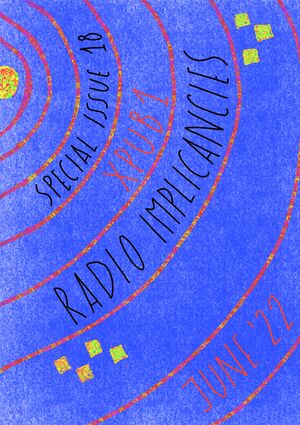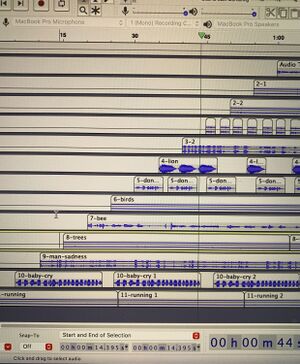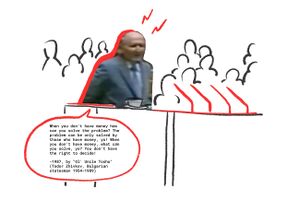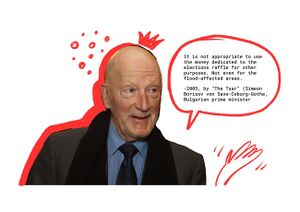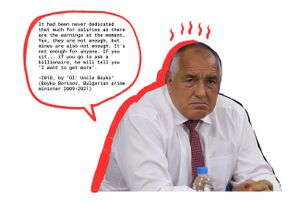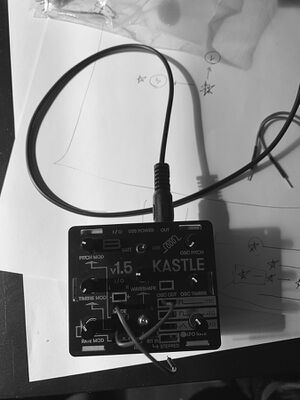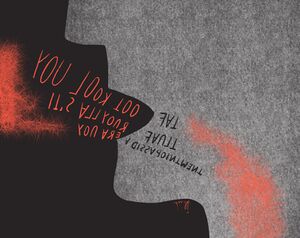Special Issue 18 Work
Concept
[everything is interconnected] [implication] [responsibility] [relationality] [becoming] [interdependency] [resonance] [interference] [entanglement] [techno-ecology]
Weekly
- week 00 [prep & setup + covid as an extra]
introduction to the special issue topic & process
personal introductions: bio by using interconnections; also later on with less/no "my", "I" [by Femke]
My parents wanted to have a boy after already having two daughters. They were so sure it will be a boy and decided to name it Alexander. I self-trained and created by practice in visual translation - putting complex concepts and ideas into images. My creations are part of who I am and I am part of my creations. I am where I am because I was always struggling with the social constructs I was expected to follow - never fitting into 9-5 jobs or following a traditional educational path. Since childhood I was discouraged to pursue a path in art, that is why it took me so long to get here :D But I got quite some various skills on the way connected to marketing, entrepreneurship, music, djing, dancing, drawing, designing... After I participated in a training in France, I became part of an association there that gave me the opportunity to completely change my path and be able to navigate it. And with them, to create space for others to gather, experiment with topics and tools they are passionate about. My need of establishing my practice and focusing brought me here.
terminology & technical setup of the studio that I missed
self-isolation & covid... #canceleverything
[pads] personal, special issue, prototypology
- week 01 [listening to our first contributions, editing on Audacity, notation]
first contributions, listening
prototyping: editing sound, effects on Audacity
writing, reading: notations - theory & experiments
work in group for next week: w/ Gersande and Carmen
[pads] personal, special issue & prototyping, reading&writing, notation experiments, notations w/ carmen & grgr
Contributions
week 01 - field recording, glitch editing w/ audacity [work w/ Emma]
[about] During the creation time for our first contribution, I was self-isolating at home because of covid; and Emma was visiting her family in Belgium. Emma suggested the idea and she later mixed the recordings so we can hear the two recordings merged. It is an interesting contrast between her being at a different place every time, whereas I was being in the same space where there was not much happening.
[field recording] We did several field recordings of the time and place we were at some given moments. The field recording format was [1] introduction of time and place; and [2] recording of the sounds in the space. We also took one photo of that moment.
[photo glitching with audacity] I became interested how Audacity can be used to create glitched images. Thus, I experimented with that on the documentation photos we took using this tutorial as a base (and a few more).

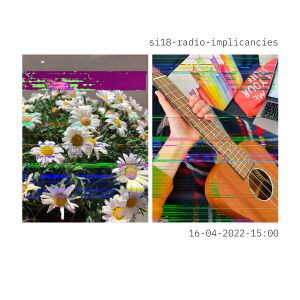
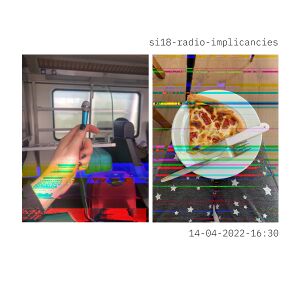
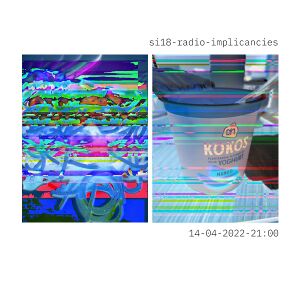
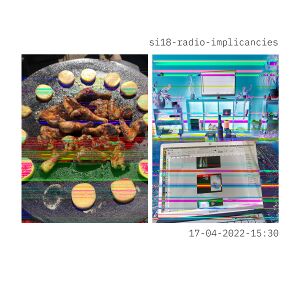
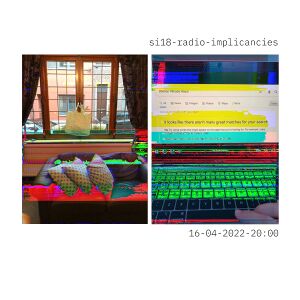
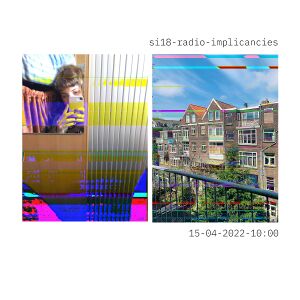
week 02 - Uneven Patterns: Are We On The Same Page? [work w/ Gersande & Carmen]
[concept] Uneven Patterns
[title] Are We On The Same Page?
[documentation] here
[about] Following a blank script, we recorded observations of what was happening around us and our thoughts to create a real fictional space.
[recording] listen here
week 03 - Voices Of Hierarchy [individual work]
[about] this experiment was triggered by Femke's week 02 class. We have read part of the chapter Language and mattering humans [Animacies: Biopolitics, Racial Mattering, and Queer Affect] and talked about objects and subjects animacy hierarchy in grammar:
Perhaps the broadest cross-linguistic study of animacy hierarchies was done by John Cherry. Cherry’s study, representing several language families and including Swahili, English, Navajo, Shona, Chi- nook, Algonquian, Hopi, Russian, Polish, and Breton, yielded a summary that roughly characterizes each station (with its own hierarchical orders) in an animacy hierarchy, and offered perhaps the most detailed summary of its kind.
This schema asserts that an adult male who is “free” (as opposed to enslaved), able-bodied, and with intact linguistic capacities, one who is also familiar, individual, and positioned nearby, stands at the top of the hierarchy as the most “animate” or active agent within grammars of ordering.
Lower down, and hence less agentive, would be, for example, a large, distant population of females. Lower still would be nonhuman animals (ranked by size). Near the bottom would be something like “sadness.”
-Mel Y. Chen, page 26-27
For this experiment, I took some random voices and ordered them following the hierarchical order presented by Mel Y. Chen and John Cherry. The loudest voice is the one on the top of the [sound] hierarchy as well - it has the highest volume.
Voices are of:
- a white man with British accent [unfamiliar man]
- Alex [me, a familiar white woman]
- a white woman with American accent [unfamiliar woman]
- a kid [nonadult]
- a lion [largest animal]
- a donkey [larger animal]
- some birds [animal]
- a bee [insect]
- trees' leaves [plant]
- a man crying [emotion]
- a sound of someone running [activity]
[process]
-after re-reading the chapter and checking John Cherry's book and his representation of the hierarchy, I collected the sounds I needed [all of them are copyright free samples + my own recording of my voice]
-the audio samples were put on audacity and ordered sorted to the hierarchal order
-from down to up, I adjusted the starting time of each sample and its volume
-applied several edits to adjust the balance, got rid of two samples
[result]
▶ listen to the recording here
▶ notation
week 04 - Getting Political: Money Talks [work w/ Mitsa]
[about] for this week's topic, that was "Parliament", with Mitsa we decided to get political. We brainstormed some ideas and decided to do parallel pieces connected to political representation. Mitsa is doing remixes of national anthems in a robotic sounding. I was looking through some iconic quotes of Bulgarian leaders during the Bulgaria's transition to democracy and market economy. There are three quotes by three statesmen:
Todor Zhivkov (Statesman 1954-1989), also called "Ol' Uncle Tosho"
He was a Bulgarian communist statesman who served as the de facto leader of the People's Republic of Bulgaria (PRB) from 1954 until 1989 as General Secretary of the Bulgarian Communist Party.
Simeon Borisov von Saxe-Coburg-Gotha (Bulgarian prime minister 2001-2005), but also the last tsar of the Kingdom of Bulgaria as Simeon II from 1943 until 1946 (with a regent, because he was 6 years old when his father died).
Boyko Borisov (Bulgarian prime minister 2009-2021) who was before that Mayor of Sofia.
[process] the first quote I selected was Zhivkov's one about money. Then, I was mainly looking for other quotes that are tackling the topic of money. When the politicians were saying those things, they were speaking in a vernacular manner, not using any high and official language.
Zhivkov and Borisov's quotes are also recorded on video. Saxe-Coburg-Gotha's quote is from a newspaper. I translated their quotes in English and then recorded them with my Mac's Spoken Content option using the voice of Daniel. Then, added some applause at the end.
[result]
▶ Todor Zhivkov: original quote vs. the recording
▶ "The Tsar" Simeon Borisov von Saxe-Coburg-Gotha: the recording
▶ Boyko Borisov: original quote vs. the recording
week 05 - Nested Narratives: What Is Left To Discuss?
05_01_ Care-taking & Editorial [work w/ Emma & Supi]
[wip]
▶ care-takers working place
▶ editorial proposal to the group
05_02_ Contribution: What's Left To Discuss? [work w/ Supi]
[title] What Is Left To Discuss?
[duration] 3:05 min
[description] A conversation piece about art: what is it for us, as makers, how do we censor ourselves and why.
[input] audio recording of our voices; audio recording of noise made with Kastle
[tools] Kastle, Macbook pro, Audacity
[process log]
- We started with some collective writing. The idea was to create a conversation by asking each other questions and answering them. We had an empty script with each of us writing something one after another.
- The text was created over 3 days. We both asked each other questions and answered them.
- Then, we recorded our conversation using an online call.
- In order to add an underscore, we produced various noises on Kastle at Supi's restaurant. Used one of them, looped it and added it to the mix.
- We had the idea to censor parts of our conversation. However, while listening to it, we decided to keep it as it is. It became a quite honest and open conversation and we shared things we wouldn't normally say in a conversation outside this setting.
Experiments
00. Notations w/ Carmen & Erika [Steve's class]
[about] During the activity we created notations which should be performed and recorded. Our trio, The Blind-Smashed-Orchestra had several ideas on which we made 5 different try-outs. Finally, we selected two of them: "the blind-smashed orchestra" and the "loop-stretch-cut". 20/04/2022
rec 1 blind-smashed-orchestra
instructions:
Imagine you are the conductor of an orchestra. Choose some musicians and form a circle with them.
start playing your masterpiece invoking the names of the instruments that will be given to each musician (f.e. you say drums looking at someone and this person will be in charge of the drums) The orchestra is a very special one. An orchestra of flat bodies laying on the ground. Blindfolded. Facing down. So as soon as you name the instrument the person in charge of it will crash on the ground and start improvise imitating that instrument. (you can choose between drums, winds, strings, vocals)
In the end join your musicians on the ground and direct your orchestra!
▶ recording
rec 2 loop-stretch-cut
instructions:
In a group of 3 people:
person 1 chooses a word and starts repeating it (as a loop)
person 2 waits a bit and starts stretching the word (as if it is stretched on Audacity)
person 3 waits a bit and starts to perform cuts of the word (as if it's cut on Audacity)
keep the performance for a while :-)
a special tribute to Manetta's homework assignment
▶ recording
rec Covers
We also did three covers of notations by Miriam and Emma:
Imagine you're the owner of a café and your coffee machine just broke down. You try imitating the sounds of a coffee machine so the customers won't notice that the coffee machine broke. ▶ recording
Hum the sound of a commercial jingle you know but with your mouth open. ▶ recording
Stare at the sun without sunglasses. Describe the feeling in a calm and juicy way.
▶ recording
01. How Does Anxiety Sound Like / individual work [prototyping]
[about] Our weekly assignment for the next prototyping class was to make a recording and use one (or more) of the effects on Audacity (repeat/stretch/cut/reverse) following some additional constrain. My first try was actually a longer piece coming from a personal need to explore some sounds and progression. Actually, I used almost all of the effects (except for reverse) for this piece:
▶ listen to how does anxiety sound like
▶ notation
[process] The core material is my voice saying "wow". Then, I changed the pitch to 2 levels down; 2 levels up and stretched them both with different rate. I repeated some of them and placed on different tracks, so they can overlap. Lower pitch sounds visualise the first signs of distress and the constant vibration/noise of the body after the climax. Higher pitches depict the moments of panic/histeria/fear or feeling of I cannot stand this anymore - the climax. Recorded and mixed on Audacity; computer microphone used.
02. Reversed Words / individual work [prototyping]
[about] Have you ever said something to a person you love that you wish you had never said? You cannot take your words back, can you? After doing the first experiment with the Audacity effects, I realised I didn't do anything with the "reverse" effect. I started thinking of what could be interesting to be reversed? Then, I quickly came up with the idea of reversing (as taking back) something you said. How would it sound to "delete" or "take back" what you said and immediately regretted. Here are some quick experiments:
▶ listen to reversed words
▶ notation
[process] First, I recorded my voice saying the three phrases. Then, I made the pitch one level down. Copied them and reversed. There is a tiny overlap between the "proper" phrase and the "reversed" one. There is another track with a slight sound on the background to fill in the silent moments between the three phrases. Recorded and edited on Audacity.
Terminology
Radio Implicancies is about practicing interdependencies. About how to stay with the complex entanglements between the personal, the economical, the political and the computational. About thinking, using and making technology with mutual relations in mind.
- agential realism
According to Barad's theory of agential realism, the universe comprises phenomena, which are "the ontological inseparability of intra-acting agencies". Intra-action, a neologism introduced by Barad, signals an important challenge to individualist metaphysics.
Key Figures
[Karen Barad] is an American feminist theorist, known particularly for their theory of agential realism. Their research topics include feminist theory, physics, twentieth-century continental philosophy, epistemology, ontology, philosophy of physics, cultural studies of science, and feminist science studies.
[Denise Ferreira Da Silva and Arjuna Neuman] our issue's title is borrowed by their film 4 Waters: Deep Implicancy is a poetical exploration of rivers, histories, volcanoes and schools of thought that flow together.[2] The “Deep implicancies” in the title of their film signals the entangled responsibilities for maintaining colonial hierarchies between what and who is considered to be of value or not. Denise Ferreira Da Silva is an academic and practicing artist, Dr. Denise Ferreira da Silva’s work addresses the ethico-political challenges of the global present. Arjuna Neuman is an artist and filmmaker based in Berlin. He works with the essay form with a multiperspectival and mobile approach where ‘essay’ is an inherently future-oriented and experimental mode, becoming the guiding principle for research and production, which shifts between the bodily, haptic and affective through to the geopolitical, planetary and cosmological.
Readings
- Barad, Karen (2007). Meeting the Universe Halfway: Quantum Physics and the Entanglement of Matter and Meaning
- Scratch Orchestra (1969) Nature Study Notes
- Simon Yuill (2008) All Problems Of Notation Will Be Solved By The Masses
- Mel Y. Chen (2012) Animacies: Biopolitics, Racial Mattering, and Queer Affect
- Roc Jiménez de Cisneros & Serafin Alvarez (2022) Are Viruses Alive?

